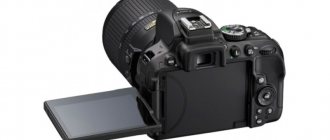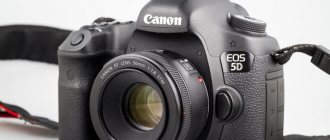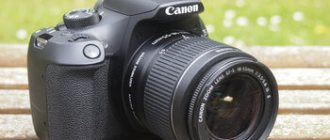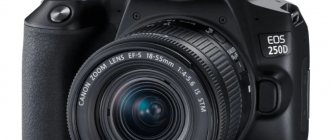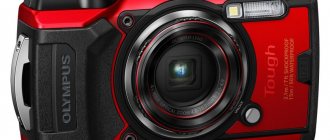The variety of power sources for cameras can be divided into two types: disposable batteries (batteries) and rechargeable sources (batteries).
Each type includes different types of batteries, which have both advantages and disadvantages. Therefore, when we choose batteries for a camera, questions often arise: what is better and more practical: a battery or an accumulator? Which batteries are better? How many times can they be recharged? To answer them, it is necessary to systematize the available data.
Features of power supplies
To operate a modern digital camera, you need electricity, the source of which is batteries - rechargeable batteries or batteries inserted into a special compartment. Camera batteries are sold already charged, ready for use. Energy is produced through chemical reactions taking place inside the source body. In this case, the properties of chemical reagents change irreversibly. Therefore, after the energy is used up, the elements are discarded.
Chemicals inside the batteries also react to produce electricity. However, after discharge, when a direct electric charging current is connected, the chemicals are restored and the camera battery is ready for use again. Such charge/discharge cycles can be up to 1000 or more without loss of capacity.
Batteries for cameras can also be divided by form factor. AA batteries have always been the most common. It is quite logical that when, as a result of miniaturization, digital cameras became compact, they began to use AA batteries and rechargeable batteries of the same type to power them. However, for high-end cameras with high energy consumption, a AA battery was not suitable. A larger power supply capacity was required.
There were two solutions: either increase the number of batteries, or make powerful batteries for a specific camera model. And of course, we shouldn’t forget about marketing: the idea of tying a buyer to a battery from a particular company is so obvious that it was impossible to ignore it.
As a result, a situation has arisen where there are two types of batteries according to their form factor: AA batteries (rarely AAA) and... the rest - with a wide variety of shapes and sizes of batteries. Is it convenient for the consumer? The question is controversial. However, there is no shortage of batteries on the market, so there are no problems purchasing the right model.
Popular brands
Manufacturers of rechargeable batteries for cameras are:
- Duracell;
- Ansmann;
- GP;
- Navigator;
- Camelion;
- Minamoto;
- Panasonic;
- Robiton;
- ET;
- Energizer;
- Varta;
- Eneloop.
Popular battery manufacturers.
The batteries of these brands have a low self-discharge rate and high capacity, but are not suitable for all cameras. For example, Sony annually releases new models and types of batteries for its own equipment. Only suitable for eligible cameras and not supported by third party devices.
You can also find cameras with LSD batteries on sale. During a year of inactivity, only 7-10% of capacity is lost. This figure is several times higher than standard nickel-metal hydride batteries.
Camera batteries differ from standard batteries in both design and purpose. There are two types: universal AA format and lithium-ion for a specific device model. The former can be used in a large number of equipment, the latter are suitable only for a specific camera model. It is necessary to charge the batteries before each shooting session - this will preserve the original capacity and extend the service life.
Disposable batteries
An obvious advantage of disposable sources is their readiness for immediate use. The battery-powered camera does not need to be recharged. Sometimes this makes a difference.
However, as already noted, AA batteries have one serious drawback, which makes you wonder whether it is worth buying batteries of this type.
This disadvantage is the small capacity. Because of this, only entry-level digital cameras that do not consume much power can operate with disposable elements.
Serious cameras are equipped with powerful rechargeable batteries, their dimensions significantly exceeding the size of a AA battery for a camera.
There are several types of disposable batteries. They all have certain advantages and disadvantages. Let's look at which batteries cameras can work quite well with, and which batteries it is better not to use for cameras at all.
Which rechargeable batteries are best for a camera?
There are several types of rechargeable AA batteries, differing in the chemical composition of the working fluid, cathode and anode material. Nickel-cadmium and lithium-ion are well-proven power sources, they are rarely used as AA batteries and are expensive. The main niche of the market, coping with its task perfectly, is occupied by nickel-metal hydride power supplies.
Nickel-metal hydride (NiMh) batteries, which have a high specific energy, have long and firmly taken their place in newfangled gadgets. The ability to recharge power sources is emphasized by the Rechargeable inscription on the product body. The battery capacity is also indicated there, measured in milliampere-hours (mAh). There is no need to try to take power supplies with the highest capacity. As practice shows, such products have an increased tendency to self-discharge. The best choice of rechargeable power source is to purchase low self-discharge nickel metal hydride (NiMh) batteries. Such products are marked with the inscription LD-NiMh. They are the ones you should choose for long and reliable operation of the camera.
Salt batteries
Due to their low cost, they are still the most common type of disposable batteries. The reason for the low cost is the availability of the raw materials necessary for their production and the simplicity of the manufacturing technology.
The main disadvantages are typical for most types of AA batteries:
- During operation, a sharp decrease in the output electrical voltage may occur;
- Low electrical capacity;
- Sensitivity to low temperatures;
- High self-discharge rate (up to 30-40% per year of the original capacity).
All of the above does not allow us to recommend this type of battery for use in cameras. In recent years, well-known manufacturers have been gradually reducing the production of salt cells, replacing it with the production of other types of batteries.
Alkaline batteries
Perhaps the most popular type of disposable batteries.
They have a number of undeniable advantages over salt batteries:
- They have 1.5 – 2 times more capacity;
- Capable of delivering a discharge more evenly (no voltage drop during discharge);
- Self-discharge over a year of storage is no more than 10% of the original capacity;
- Less sensitive to low temperatures.
However, alkaline batteries are also not without their disadvantages:
- Quite a high cost (4-5 times higher than saline ones)
- Rapid loss of capacity when used in electrical appliances that require short-term significant current levels.
Despite their higher performance compared to salt batteries, alkaline batteries do not have all the necessary characteristics necessary for full use in professional and semi-professional cameras. But for use in cameras of a lower class, they can be fully recommended.
Eneloop XX batteries from Sanyo
This product has been on the market since 2005 and can rightfully be called legendary. They are based on technology that dictates market development in this area.
AA and nickel-metal hydride batteries released by Sanyo can retain their charge for 5 years. New Eneloop batteries are designed to operate for 1800 charge and discharge cycles. The previous generation lasted 1,500 cycles, which is 20% less than the new product.
Perhaps these batteries are one of the best on the market at the moment. The problem is that they are not so easy to find everywhere. However, other companies are actively improving LD-NiMh battery technology. Products from Energizer, Duracell or Ansmann are available in abundance. For example, you can find batteries with an increased capacity of 2500 mAh, which, accordingly, increases their operating time.
Lithium batteries
The best of all disposable batteries.
Despite the rather complex design, more and more manufacturers are switching to their production, since this type of element has high performance characteristics:
- Capacity 2 times greater than that of alkaline ones,
- Uniform voltage output throughout the entire operating period, regardless of the load current
- Long (12-15 years) shelf life without loss of charge:
- Can operate at ambient temperatures from – 40°C to + 50°C;
- Light weight.
The main disadvantage is the price. Lithium batteries cost approximately 5 times more than alkaline batteries. And although their characteristics are well suited for digital cameras, using them as the main power source is very unprofitable economically. But as an alternative to batteries in the absence of an energy source to recharge the batteries, they are ideal. If, of course, the camera allows for the use of AA type elements.
More about NiMh batteries
If you have chosen NiMh batteries, then it’s time to find out that they are not the same. It just so happens that not all manufacturers provide the buyer with comprehensive information about their product, limiting themselves to a couple of phrases like “ready to use.” However, in reality there are several types of NiMh batteries. The first of them are ordinary NiMh, they consume charge even when the device is at rest. On the first day, about 23-24% of the charge is consumed, and another 1% on each subsequent day. Having carried out simple calculations, we see that more than half of the charge is consumed per month just like that.
The second type of battery is LD-NiMh. As mentioned above, this abbreviation stands for “low self-discharge”. If you do not use such devices, they will retain their charge at 85% for a year. That is, by charging such batteries and putting them in your bag, after any time during the photo shoot you can safely use them and not be afraid that they will run out at the wrong moment.
Thus, the difference is obvious: regular NiMhs will have to be recharged before each shoot, LD-NiMhs can remain charged for a whole year.
Rechargeable batteries
The vast majority of photographic equipment manufacturers have taken the path of using rechargeable batteries in their cameras rather than disposable batteries.
Firstly, the use of disposable batteries imposes certain restrictions on the power consumption of cameras, forcing it to be calculated based on the capabilities of the batteries, and not vice versa.
Secondly, until cheap types of AA batteries with the required energy characteristics have been created, producing cameras for disposable batteries will be a bad solution. The consumer should not be allowed to spend more on batteries than the camera costs.
What types of camera batteries are there? AA batteries are widely used in compact digital cameras and ultrasonic cameras. Due to their limited size, soap dishes sometimes use AAA batteries. The rest of the cameras are mainly equipped with individually sized batteries.
Therefore, types of rechargeable batteries will be identified and considered based on the technologies and materials used in their production.
Nickel-cadmium batteries (NiCd)
Used since the mid-20th century. They began to be used in photography as flash batteries. Due to their reliability and proven manufacturing technology, they are still quite common in photographic equipment.
Main advantages:
- Can operate in a wide range of ambient temperatures;
- Capable of generating large currents, which is important for the operation of the camera in some modes;
- Withstand a large number (more than 1000) charge-discharge cycles without significant loss of capacity;
- They have a long shelf life without loss of performance;
- Low price.
Flaws:
- Presence of memory effect. In this regard, it is necessary to periodically completely discharge the battery with subsequent mandatory charging;
- High self-discharge (up to 10% in the first day)
- Relatively large sizes of other types of batteries;
- Difficulties with disposal due to the presence of hazardous chemicals.
The share of NiCd batteries is gradually decreasing.
Nickel metal hydride (NiMH) batteries
When NiMH batteries appeared (in the 80s of the 20th century), they were positioned as a replacement for nickel-cadmium batteries. However, the first models were inferior to their predecessors in many respects. Only a few years ago there was some progress in overcoming the shortcomings of the technology and they began to be used as batteries for cameras.
Advantages of batteries of this type:
- They have a 30% higher capacity compared to NiCd batteries;
- There is virtually no memory effect (without a long break in operation);
- They have less toxicity.
There are disadvantages and, unfortunately, quite serious ones:
- The number of charge/discharge operating cycles is almost 2 times smaller compared to nickel-cadmium batteries;
- 1.5 - 2 times higher self-discharge;
- High price.
The developers claim that this technology has great potential for improvement, and models with significantly higher performance are expected to appear in the near future.
Lithium-ion batteries (Li-ion)
With the advent of lithium-ion batteries in the early 90s of the last century, photographic equipment manufacturers received power sources that satisfy almost all needs when operating cameras. The best rechargeable batteries are produced using this technology.
The advantages include:
- High capacity, approximately 2 times the capacity of NiCd batteries;
- Ability to produce high voltage values;
- Compactness;
- Low self-discharge values (approximately 2-5% per month);
- Wide range of operating temperatures (from -20 to + 50 °C);
- Quite a large number of charge/discharge operating cycles (600-900);
- Low maintenance requirements.
The disadvantages include:
- Susceptibility to aging (failure of unused batteries that have been in storage for several years);
- Failure due to deep discharge;
- High price;
- Explosion hazard of some models.
Helpful advice! Do not buy a lithium battery in reserve if you do not intend to use it at least from time to time.
A further development of lithium-ion batteries was the emergence of lithium-polymer batteries (Li-Pol). Having inherited high capacity and stability of the output voltage, they are significantly smaller in size and can be given a variety of shapes without loss of capacity. This opens up prospects for photographic equipment manufacturers to produce more compact models.
How to use the battery and charger correctly
Lithium-ion batteries are subject to gradual discharge, even when the device is turned off. Therefore, the capacity level must be checked before starting work, especially if there is no outlet nearby. New batteries are usually discharged - they should be charged several times and fully charged so that the capacity is at its maximum level.
In some cases, even when you connect it to the charger for the first time, you can see that the camera is fully charged. This is an internal error caused by the security system. In this case, you need to remove the battery from the charger and turn it on again. During operation, you should also not drop, wet, scratch or keep the battery near fire. It is equally important to use a branded power adapter when replenishing the capacity, since chargers that are not suitable for power can lead to a short circuit and damage the camera.
Selection options and recommendations
When choosing batteries for your camera, you must, first of all, strictly follow the recommendations of the photographic equipment manufacturer as set out in the operating instructions. For example, the instructions stipulate that only a battery from this company should be used for a Canon camera. This is especially true during the warranty period. Failure of photographic equipment that did not use original batteries may be considered a non-warranty event with unpleasant consequences for the owner.
If the design of the camera allows the use of disposable AA cells, you should opt for lithium batteries from well-known brands. They are expensive, but they are the best batteries on the market. Firstly, they will allow you to take many more photographs than alkaline elements (not to mention saline ones).
Secondly, when operating in the camera, power supplies are subject to maximum load and become very hot. Batteries produced by unknown companies in a semi-handicraft manner may become unusable or even ignite. Naturally, the batteries should not be damaged.
If you nevertheless decide to purchase a non-original power source for the camera, then you must follow several rules:
- Buy a model from reliable manufacturers (list below). Purchasing a cheap product from an unknown company can result in a major nuisance;
- The batteries purchased must be manufactured using the same technology as the original ones. For example, a lithium-ion battery cannot be replaced with a nickel-cadmium battery of the same capacity and giving the same output voltage. The latter cannot provide a short-term supply of large current, and the camera may become unusable;
- It is necessary to purchase chargers for specific battery models. The latest generation of power sources are very sensitive to compliance with charging/discharging modes. The use of third-party chargers greatly shortens the life of the batteries and reduces their capacity.
Battery Features
There are two types of batteries available for purchase: lithium-ion and AA. The second type of battery has gained popularity due to its low price. As a rule, cameras powered by AA batteries are supplied without a charger and require a universal solution.
Lithium-ion battery for camera.
More expensive lithium-ion batteries are used only with devices of a specific brand and brand: Canon, Nikon, Pentax, Olympus, Sony, etc. They are usually included with the camera. At the same time, lithium-ion batteries can be inserted into equipment from the same manufacturer if the connectors match. Also, if the battery is included, you need to check the presence of a charger. It is also used as a network adapter and protects the device from sudden surges in network voltage. It is necessary to check the package before purchasing, because it can be difficult to find an additional battery, and it is not cheap.
In order for the camera and battery to last for several years, the replenishment process must be carried out correctly. Charging the battery involves using a special charger. Some models allow you not to remove the battery for charging - just connect the equipment to the charger via a cable.
The battery must be recharged before long periods of shooting. To do this, you can purchase additional memory or a battery, which will allow you to take more photos in one session. Also, unlike nickel-cadmium and nickel-zinc, lithium-ion batteries can be recharged at any time without loss of service life.
The power cables that connect to the charger come in several types: standard ones with a USB connector, and car ones from the cigarette lighter. It is important to remember that both the charger and the wire must match the brand. For example, for Sony devices you need to buy batteries from the same manufacturer.

